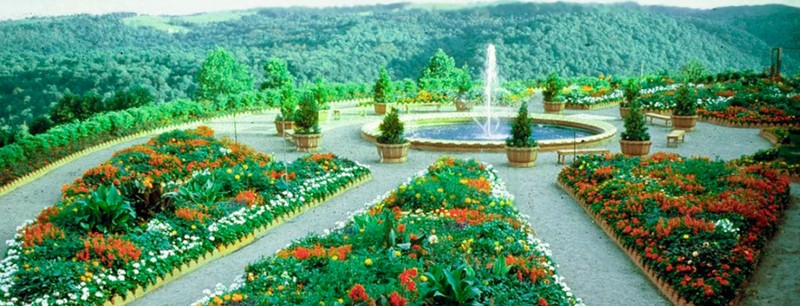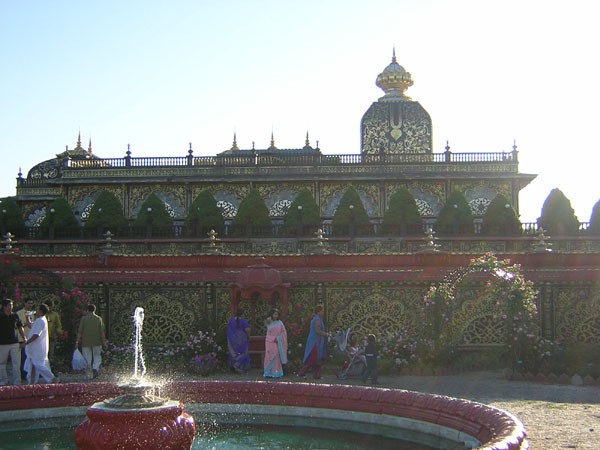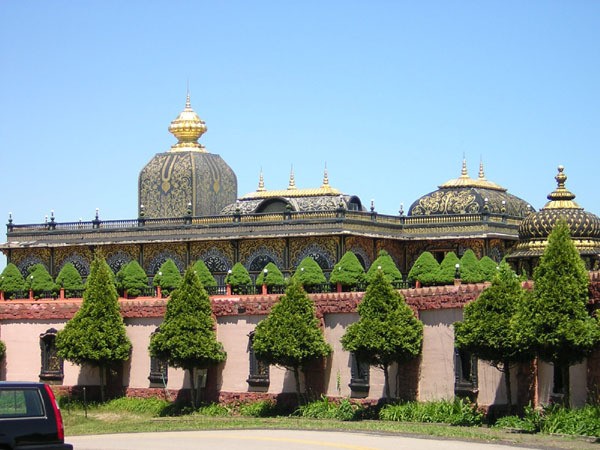Palace of Gold, New Vrindaban
Introduction
Text-to-speech Audio
Images
New Vrindaban Palace of Gold The Palace was created without any architectural design and was intended to serve as the first of seven temples in New Vrindaban.

New Vrindaban Community Gardens

Statue of A. C. Bhaktivedanta Swami Prabhupadau

Side view of the Palace.

2007 View of the Palace.

Backstory and Context
Text-to-speech Audio
In 1968 Pranhupada’s disciple, Kirtanada Swami created the community of New Vrindaban, and by the 1980’s the community comprised over 3,000 acres. The creation of a New Vrindaban was one of the goals that Pranhupada wanted to achieve through his movement and he spoke of it often. Pranhupada planned to retire to New Vrindaban to write his commentaries on the Vedic scripture. Members of the ISKCON increasingly moved to New Vrindaban to either aid in the construction of what became the Palace of Gold, the personal charisma of Kirtanananda, or because the community would take in the “problem devotees”, those who were not accepted by other sects of the movement. From 1975 to the mid-1980’s the community would continue to grow from a population of 120 to 500.
Plans to construct Pranhupada's home began in 1973 which was originally designed to be a small house. Pranhupada last visited New Vrindaban in 1976 before his death the following year and on September 2, 1979, two years after his death, the Palace of Gold was dedicated in his memory. As construction continued the design of the home grew and the Palace of Gold took shape turning the home into a memorial. The Palace of Gold welcomed tens of thousands of visitors when its doors first opened, rising to 100,000 in 1982, and nearly half a million the following year. Media outlets praised the Palace, CNN naming it one of the 8 religious wonders in the country, The New York Times called it “America’s Taj Mahal”, and was described as “Almost Heaven” by The Washington Post. For the movement's followers, it became a place of pilgrimage, welcoming thousands of faithful each year.
New Vrindaban employes one of the largest workforces in Marshall County, West Virginia, with a staff of 187 people outside their faith and community. This was accomplished through the wealth brought in by tourism to the Palace of Gold and was used in the plans to create the world’s largest Radha-Krishna temple. The mid-1980’s brought incidents of violence to the community as Kirtanananda was attacked in the fall of 1985, suffering a major head injury, and a former residence, and critic, was murdered in 1986. These incidents and the subsequent investigation by state and federal authorities undermined the authority of Kirtanananda and began the decline of the community. New Vrindaban declined in population after 1986, falling from the 377 adults down to 131 by 1991, with many leaving to join other ISKCON temples. In 2009, of the 125 followers of ISKCON living in the region 50 lived in the temple community, but of the other 75, few maintained regular, if any, contact with the community.
Sources
Csomor, Marina, “8 Religious Wonders to See in the U.S.” CNN, last modified November 30, 2017, accessed July 20, 2018. https://www.cnn.com/travel/article/beautiful-religious-sites-us/index.html
Rochford Jr., E. Burke, Violence and New Religious Movements, Knocking on Heavens Door, Oxford University Press, 1st edition, 2011
"New Vrindaban, West Virginia." Wikipedia. Accessed October 1, 2020. https://en.wikipedia.org/wiki/New_Vrindaban,_West_Virginia#Prabhupada's_Palace_of_Gold.
"New Vrindaban, West Virginia." Wikipedia. Accessed October 1, 2020. https://en.wikipedia.org/wiki/New_Vrindaban,_West_Virginia#Prabhupada's_Palace_of_Gold.
"New Vrindaban, West Virginia." Wikipedia. Accessed October 1, 2020. https://en.wikipedia.org/wiki/New_Vrindaban,_West_Virginia#Prabhupada's_Palace_of_Gold.
